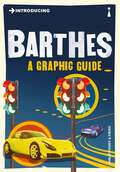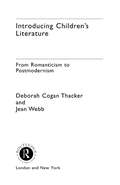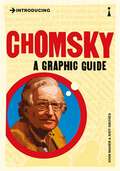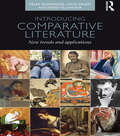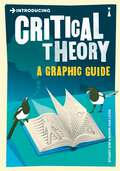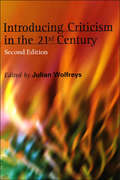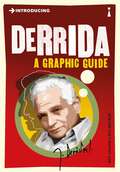- Table View
- List View
Introducing Audiovisual Translation
by Agnieszka Szarkowska Anna JankowskaThis pioneering book, Introducing Audiovisual Translation, offers comprehensive insights into all facets of audiovisual translation and media localisation.The book serves as a comprehensive guide spanning seven chapters and begins by introducing you to audiovisual translation (AVT). It goes on to explore the historical backdrop and highlight the distinctions from traditional written text translation. The authors expertly navigate you through the primary AVT modalities: interlingual subtitling, dubbing, voice-over, subtitling for the deaf and hard of hearing, live subtitling, and audio description.A blend of theoretical concepts and practical, real-world examples in various languages ensures a seamless understanding of the fundamental principles of AVT. It clearly guides you through the most important aspects of each type of AVT.Designed for those exploring various AVT forms, budding audiovisual translators, and those interested in contemporary AVT trends and research, this book is an invaluable resource for enthusiasts in the field, spanning translation, linguistic students, and educators in AVT across higher education and media localisation programmes.
Introducing Barthes: A Graphic Guide (Introducing...)
by Philip ThodyINTRODUCING guide to the cult author, semiologist and analyzer of advertising, Roland Barthes. Roland Barthes is best known as a semiologist, a student of the science of signs. This sees human beings primarily as communicating animals, and looks at the way they use language, clothes, gestures, hair styles, visual images, shapes and colour to convey to one another their tastes, their emotions, their ideal self-image and the values of their society. Introducing Barthes brilliantly elucidates Barthes' application of these ideas to literature, popular culture, clothes and fashion, and explains why his thinking in this area made him a key figure in the structuralist movement of the 1960s. It goes on to describe how his later insistence on pleasure, the delights of sexual non-conformity, and the freedom of the reader to interpret literary texts in the light of ideologies such as existentialism, Marxism and Freudianism, as well as structuralism itself, continues to make him one of the most dynamic and challenging of modern writers. This is the perfect companion volume to Introducing Semiotics.
Introducing Business English (Routledge Introductions to English for Specific Purposes)
by Catherine Nickerson Brigitte PlankenIntroducing Business English provides a comprehensive overview of this topic, situating the concepts of Business English and English for Specific Business Purposes within the wider field of English for Special Purposes. This book draws on contemporary teaching and research contexts to demonstrate the growing importance of English within international business communication. Covering both spoken and written aspects of Business English, this book: examines key topics within Business English, including teaching Business English as a lingua franca, intercultural business interactions, blended learning and web-based communication; discusses the latest research on each topic, and possible future directions; features tasks and practical examples, a section on course design, and further resources. Written by two leading researchers and teachers, Introducing Business English is a must-read for advanced undergraduate and postgraduate students studying Business English, Business English as a Lingua Franca, and English for Specific Business Purposes.
Introducing Business English (Routledge Introductions to English for Specific Purposes)
by Catherine Nickerson Brigitte PlankenIntroducing Business English provides a comprehensive overview of this topic, situating the concepts of Business English and English for Specific Business Purposes within the wider field of English for Special Purposes. This book draws on contemporary teaching and research contexts to demonstrate the growing importance of English within international business communication. Covering both spoken and written aspects of Business English, this book: examines key topics within Business English, including teaching Business English as a lingua franca, intercultural business interactions, blended learning and web-based communication; discusses the latest research on each topic, and possible future directions; features tasks and practical examples, a section on course design, and further resources. Written by two leading researchers and teachers, Introducing Business English is a must-read for advanced undergraduate and postgraduate students studying Business English, Business English as a Lingua Franca, and English for Specific Business Purposes.
Introducing Children's Literature: From Romanticism to Postmodernism
by Deborah Cogan Thacker Jean WebbIntroducing Children's Literature is an ideal guide to reading children's literature through the perspective of literary history. Focusing on the major literary movements from Romanticism to Postmodernism, Thacker and Webb examine the concerns of each period and the ways in which these concerns influence and are influenced by the children's literature of the time. Each section begins with a general chapter, which explains the relationship between the major issues of each literary period and the formal and thematic qualities of children's texts. Close readings of selected texts follow to demonstrate the key defining characteristics of the form of writing and the literary movements. Original in its approach, this book sets children's literature within the context of literary movements and adult literature. It is essential reading for students studying writing for children. Books discussed include: *Louisa May Alcott's Little Women* Charles Kingsley's The Water-Babies *Lewis Carroll's Alice in Wonderland*Frank Baum's The Wizard of Oz*Frances Hodgson Burnett's The Secret Garden*P.L.Travers' Mary Poppins*E.B.White's Charlotte's Web*Philip Pullman's Clockwork.
Introducing Children's Literature: From Romanticism to Postmodernism
by Deborah Cogan Thacker Jean WebbIntroducing Children's Literature is an ideal guide to reading children's literature through the perspective of literary history. Focusing on the major literary movements from Romanticism to Postmodernism, Thacker and Webb examine the concerns of each period and the ways in which these concerns influence and are influenced by the children's literature of the time. Each section begins with a general chapter, which explains the relationship between the major issues of each literary period and the formal and thematic qualities of children's texts. Close readings of selected texts follow to demonstrate the key defining characteristics of the form of writing and the literary movements. Original in its approach, this book sets children's literature within the context of literary movements and adult literature. It is essential reading for students studying writing for children. Books discussed include: *Louisa May Alcott's Little Women* Charles Kingsley's The Water-Babies *Lewis Carroll's Alice in Wonderland*Frank Baum's The Wizard of Oz*Frances Hodgson Burnett's The Secret Garden*P.L.Travers' Mary Poppins*E.B.White's Charlotte's Web*Philip Pullman's Clockwork.
Introducing Chomsky: A Graphic Guide (Introducing...)
by John MaherCan it be that the human brain possesses an in-built faculty for language? Noam Chomsky, one of the most brilliant linguists of the 20th century, believes that it does- that there exists a 'universal grammar' common to all languages. Around the world children learn, in very similar ways, languages that seem entirely different. This is possible, Chomsky argues, because all human languages and their grammatical structures are linked in the human brain. Chomsky is controversial and yet highly influential, both in his pioneering work in linguistics and in his unrelenting critique of international power and his commitment to freedom and justice. These two 'Chomskys' are heirs to the Enlightenment tradition, and this book is the ideal introduction to them both.
Introducing Comparative Literature: New Trends and Applications
by César Domínguez Haun Saussy Darío VillanuevaIntroducing Comparative Literature is a comprehensive guide to the field offering clear, concise information alongside useful analysis and examples. It frames the introduction within recent theoretical debates and shifts in the discipline whilst also addressing the history of the field and its practical application. Looking at Comparative Literature within the context of globalization, cosmopolitanism and post or transnationalism, the book also offers engagement and comparison with other visual media such as cinema and e-literature. The first four chapters address the broad theoretical issues within the field such as ‘interliterary theory’, decoloniality, and world literature, while the next four are more applied, looking at themes, translation, literary history and comparison with other arts. This engaging guide also contains a glossary of terms and concepts as well as a detailed guide to further reading.
Introducing Comparative Literature: New Trends and Applications
by César Domínguez Haun Saussy Darío VillanuevaIntroducing Comparative Literature is a comprehensive guide to the field offering clear, concise information alongside useful analysis and examples. It frames the introduction within recent theoretical debates and shifts in the discipline whilst also addressing the history of the field and its practical application. Looking at Comparative Literature within the context of globalization, cosmopolitanism and post or transnationalism, the book also offers engagement and comparison with other visual media such as cinema and e-literature. The first four chapters address the broad theoretical issues within the field such as ‘interliterary theory’, decoloniality, and world literature, while the next four are more applied, looking at themes, translation, literary history and comparison with other arts. This engaging guide also contains a glossary of terms and concepts as well as a detailed guide to further reading.
Introducing Corpora in Translation Studies
by Maeve OlohanThe use of corpora in translation studies, both as a tool for translators and as a way of analyzing the process of translation, is growing. This book provides a much-needed assessment of how the analysis of corpus data can make a contribution to the study of translation.Introducing Corpora in Translation Studies: traces the development of corpus methods within translation studies defines the types of corpora used for translation research, discussing their design and application and presenting tools for extracting and analyzing data examines research potential and methodological limitatis considers some uses of corpora by translators and in translator training features research questions, case studies and discussion points to provide a practical guide to using corpora in translation studies. Offering a comprehensive account of the use of corpora by today's translators and researchers, Introducing Corpora in Translation Studies is the definitive guide to a fast-developing area of study.
Introducing Corpora in Translation Studies
by Maeve OlohanThe use of corpora in translation studies, both as a tool for translators and as a way of analyzing the process of translation, is growing. This book provides a much-needed assessment of how the analysis of corpus data can make a contribution to the study of translation.Introducing Corpora in Translation Studies: traces the development of corpus methods within translation studies defines the types of corpora used for translation research, discussing their design and application and presenting tools for extracting and analyzing data examines research potential and methodological limitatis considers some uses of corpora by translators and in translator training features research questions, case studies and discussion points to provide a practical guide to using corpora in translation studies. Offering a comprehensive account of the use of corpora by today's translators and researchers, Introducing Corpora in Translation Studies is the definitive guide to a fast-developing area of study.
Introducing Course Design in English for Specific Purposes (Routledge Introductions to English for Specific Purposes)
by Lindy WoodrowIntroducing Course Design in English for Specific Purposes is an accessible and practical introduction to the theory and practice of developing ESP courses across a range of disciplines. The book covers the development of courses from needs analysis to assessment and evaluation, and also comes with samples of authentic ESP courses provided by leading ESP practitioners from a range of subject and global contexts. Included in this book are: The basics of ESP course design The major current theoretical perspectives on ESP course design Tasks, reflections and glossary to help readers consolidate their understanding Resources for practical ESP course development Examples of authentic ESP courses in areas such as business, aviation and nursing Introducing Course Design in English for Specific Purposes is essential reading for pre-service and in-service teachers, and students studying ESP and applied linguistics.
Introducing Course Design in English for Specific Purposes (Routledge Introductions to English for Specific Purposes)
by Lindy WoodrowIntroducing Course Design in English for Specific Purposes is an accessible and practical introduction to the theory and practice of developing ESP courses across a range of disciplines. The book covers the development of courses from needs analysis to assessment and evaluation, and also comes with samples of authentic ESP courses provided by leading ESP practitioners from a range of subject and global contexts. Included in this book are: The basics of ESP course design The major current theoretical perspectives on ESP course design Tasks, reflections and glossary to help readers consolidate their understanding Resources for practical ESP course development Examples of authentic ESP courses in areas such as business, aviation and nursing Introducing Course Design in English for Specific Purposes is essential reading for pre-service and in-service teachers, and students studying ESP and applied linguistics.
Introducing Critical Theory: A Graphic Guide (Introducing... #0)
by Professor Stuart SimWhat might a 'theory of everything' look like? Is science an ideology? Who were Adorno, Horkheimer or the Frankfurt School? The decades since the 1960s have seen an explosion in the production of critical theories. Deconstructionists, poststructuralists, postmodernists, second-wave feminists, new historicists, cultural materialists, postcolonialists, black critics and queer theorists, among a host of others, all vie for our attention. Stuart Sim and Borin Van Loon's incisive graphic guide provides a route through the tangled jungle of competing ideas and provides an essential historical context, situating these theories within tradition of critical analysis going back to the rise of Marxism. They present the essential methods and objectives of each theoretical school in an incisive and accessible manner, and pay special attention to recurrent themes and concerns that have preoccupied a century of critical theoretical activity.
Introducing Criticism in the 21st Century
by Julian WolfreysProvides a wide-ranging guide to current directions in literary criticism This new and revised edition provides 14 chapters introducing new modes of 'hybrid' criticism which have emerged in the twenty-first century. The chapters provide thought-provoking overviews of critical thinking at the cutting edge. Each of the authors explains in lucid terms the various contours of their discourses while bringing these into sharp relief for the student reader through readings of canonical novels, poems, plays, films and websites. The book is organised into five areas of critical concern †“ The Poetics and Politics of Identity; Critical Voices: Ethical Questions; Materialities, Immaterialities, (A)materialities, Realities; Space, Place & Memory. These orientations reflect the increasingly interdisciplinary nature of critical and cultural studies, as do the themes covered within the volume: Diaspora Criticism, Gender and Transgender Criticism, Women of Color and Feminist Criticism, Chaos Theory, Complexity Theory and Criticism, Ethical Criticism, Trauma and Testimonial Criticism, Ecocriticism, Spatial Criticism, Cybercriticism, Deleuzean Criticism, Levinas and Criticism, Spectral Criticism and (A)material Criticism. New for this edition: 6 new chapters addressing new approaches to criticism A revised introduction Key Features: Addresses the various 'states of criticism' at the beginning of the century Each chapter explores and explains aspects of the theory it addresses, provides a brief 3-4 page reading of a literary text, film text or website and concludes with questions for further consideration, an annotated bibliography and a supplementary bibliography The critical readings provide a teaching and study resource and demonstrate the scope of theoretical applications
Introducing Derrida: A Graphic Guide (Introducing... #0)
by Jeff CollinsBrilliant illustrated guide to the best-known and most controversial continental philosopher of the latter 20th century. Jacques Derrida is the most famous philosopher of the late 20th century. Yet Derrida has undermined the rules of philosophy, rejected its methods, broken its procedures and contaminated it with literary styles of writing. Derrida's philosophy is a puzzling array of oblique, deviant and yet rigorous tactics for destabilizing texts, meanings and identities. 'Deconstruction', as these strategies have been called, is reviled and celebrated in equal measure. Introducing Derrida introduces and explains his work, taking us on an intellectual adventure that disturbs some of our most comfortable habits of thought.
Introducing Discourse Analysis: From Grammar to Society
by James Paul GeeIntroducing Discourse Analysis: From Grammar to Society is a concise and accessible introduction by bestselling author, James Paul Gee, to the fundamental ideas behind different specific approaches to discourse analysis, or the analysis of language in use. The book stresses how grammar sets up choices for speakers and writers to make, choices which express, not unvarnished truth, but perspectives or viewpoints on reality. In turn, these perspectives are the material from which social interactions, social relations, identity, and politics make and remake society and culture. The book also offers an approach to how discourse analysis can contribute to lessening the ideological divides and echo chambers that so bedevil our world today. Organized in a user-friendly way with short numbered sections and recommended readings, Introducing Discourse Analysis is an essential primer for all students of discourse analysis within linguistics, education, communication studies, and related areas.
Introducing Discourse Analysis: From Grammar to Society
by James Paul GeeIntroducing Discourse Analysis: From Grammar to Society is a concise and accessible introduction by bestselling author, James Paul Gee, to the fundamental ideas behind different specific approaches to discourse analysis, or the analysis of language in use. The book stresses how grammar sets up choices for speakers and writers to make, choices which express, not unvarnished truth, but perspectives or viewpoints on reality. In turn, these perspectives are the material from which social interactions, social relations, identity, and politics make and remake society and culture. The book also offers an approach to how discourse analysis can contribute to lessening the ideological divides and echo chambers that so bedevil our world today. Organized in a user-friendly way with short numbered sections and recommended readings, Introducing Discourse Analysis is an essential primer for all students of discourse analysis within linguistics, education, communication studies, and related areas.
Introducing Electronic Text Analysis: A Practical Guide for Language and Literary Studies
by Svenja AdolphsIntroducing Electronic Text Analysis is a practical and much needed introduction to corpora – bodies of linguistic data. Written specifically for students studying this topic for the first time, the book begins with a discussion of the underlying principles of electronic text analysis. It then examines how these corpora enhance our understanding of literary and non-literary works. In the first section the author introduces the concepts of concordance and lexical frequency, concepts which are then applied to a range of areas of language study. Key areas examined are the use of on-line corpora to complement traditional stylistic analysis, and the ways in which methods such as concordance and frequency counts can reveal a particular ideology within a text. Presenting an accessible and thorough understanding of the underlying principles of electronic text analysis, the book contains abundant illustrative examples and a glossary with definitions of main concepts. It will also be supported by a companion website with links to on-line corpora so that students can apply their knowledge to further study. The accompanying website to this book can be found at http://www.routledge.com/textbooks/0415320216
Introducing Electronic Text Analysis: A Practical Guide for Language and Literary Studies
by Svenja AdolphsIntroducing Electronic Text Analysis is a practical and much needed introduction to corpora – bodies of linguistic data. Written specifically for students studying this topic for the first time, the book begins with a discussion of the underlying principles of electronic text analysis. It then examines how these corpora enhance our understanding of literary and non-literary works. In the first section the author introduces the concepts of concordance and lexical frequency, concepts which are then applied to a range of areas of language study. Key areas examined are the use of on-line corpora to complement traditional stylistic analysis, and the ways in which methods such as concordance and frequency counts can reveal a particular ideology within a text. Presenting an accessible and thorough understanding of the underlying principles of electronic text analysis, the book contains abundant illustrative examples and a glossary with definitions of main concepts. It will also be supported by a companion website with links to on-line corpora so that students can apply their knowledge to further study. The accompanying website to this book can be found at http://www.routledge.com/textbooks/0415320216
Introducing English As An Additional Language To Young Children: A Practical Handbook (PDF)
by Kay Crosse'A definite must-have for all teachers of English confronted with early multilingualism' - Times Educational Supplement
Introducing English for Academic Purposes (Routledge Introductions to English for Specific Purposes)
by Maggie Charles Diane PecorariIntroducing English for Academic Purposes is an accessible and engaging textbook which presents a wide-ranging introduction to the field, covering the global and institutional position of EAP as well as its manifestations in classrooms and research contexts around the world. Each chapter provides: a critical overview introducing readers to theory- and research-informed perspectives; profiles of practice to guide readers in putting theory to use in real world contexts; tasks, reflection exercises and a glossary to help readers consolidate their understanding; an annotated further reading section with links to online resources to enable readers to extend their knowledge. Covering both theoretical and practical issues, Introducing English for Academic Purposes is essential reading for studentsof applied linguistics, and pre-service and in-service teachers of EAP.
Introducing English for Academic Purposes (Routledge Introductions to English for Specific Purposes)
by Maggie Charles Diane PecorariIntroducing English for Academic Purposes is an accessible and engaging textbook which presents a wide-ranging introduction to the field, covering the global and institutional position of EAP as well as its manifestations in classrooms and research contexts around the world. Each chapter provides: a critical overview introducing readers to theory- and research-informed perspectives; profiles of practice to guide readers in putting theory to use in real world contexts; tasks, reflection exercises and a glossary to help readers consolidate their understanding; an annotated further reading section with links to online resources to enable readers to extend their knowledge. Covering both theoretical and practical issues, Introducing English for Academic Purposes is essential reading for studentsof applied linguistics, and pre-service and in-service teachers of EAP.
Introducing English for Research Publication Purposes
by John Flowerdew Pejman HabibieThere has been growing scholarly research and interest in writing for academic publication over the past decade and the field of English for Research Publication Purposes (ERPP) has established itself as an important domain within English for Academic Purposes (EAP). This introductory volume provides a comprehensive view of what ERPP encompasses as a scholarly field, including its disciplinary boundaries, competing discourses within the field, research and practice paradigms, and future prospects for research and pedagogy in this field. The book portrays a multifaceted and nuanced picture of the discourses and discussions shaping and underlying ERPP as a scholarly field, focusing on key aspects of ERPP including: emergence and expansion of ERPP; key theoretical and methodological orientations framing ERPP research; writing for scholarly publication practices of EAL, Anglophone, and early-career scholars and graduate students; the pedagogy of ERPP and relevant international policies, practices, and initiatives; the advancement of digital technologies and the implications for ERPP; new directions in ERPP practice and research. This book is essential reading for students and scholars within the areas of applied linguistics, TESOL, and English for Academic Purposes.
Introducing English for Research Publication Purposes
by John Flowerdew Pejman HabibieThere has been growing scholarly research and interest in writing for academic publication over the past decade and the field of English for Research Publication Purposes (ERPP) has established itself as an important domain within English for Academic Purposes (EAP). This introductory volume provides a comprehensive view of what ERPP encompasses as a scholarly field, including its disciplinary boundaries, competing discourses within the field, research and practice paradigms, and future prospects for research and pedagogy in this field. The book portrays a multifaceted and nuanced picture of the discourses and discussions shaping and underlying ERPP as a scholarly field, focusing on key aspects of ERPP including: emergence and expansion of ERPP; key theoretical and methodological orientations framing ERPP research; writing for scholarly publication practices of EAL, Anglophone, and early-career scholars and graduate students; the pedagogy of ERPP and relevant international policies, practices, and initiatives; the advancement of digital technologies and the implications for ERPP; new directions in ERPP practice and research. This book is essential reading for students and scholars within the areas of applied linguistics, TESOL, and English for Academic Purposes.

